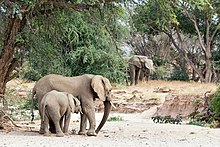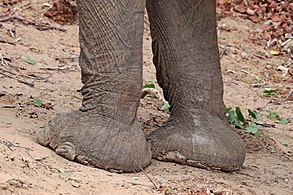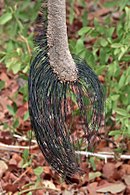Desert elephant

Huab River in Namibia

Desert elephants or desert-adapted elephants are not a distinct species of elephant but are African bush elephants (Loxodonta africana) that have made their homes in the Namib and Sahara deserts in Africa. Previously they were classified as a subspecies of the African bush elephant, but this is no longer the case. Desert-dwelling elephants were once more widespread in Africa than they are at present; they are currently found only in Namibia and Mali. They tend to migrate from one waterhole to another following traditional routes which depend on the seasonal availability of food and water. They face being threatened by poaching and from changes in land use by humans.
Namibia
The Kunene Region in the northwest of Namibia is an area of mostly sandy desert, rocky mountains and stony plains; it covers about 115,154 square kilometres (44,461 sq mi).[1] Elephants have traditionally lived in this area and in the earlier part of the 20th century there were about 3,000 in the Kunene Region. By the 1980s these had greatly diminished in number, however since then, conservation measures have been put in place and by 2013 the number of elephants had increased to about 600.[2] In 1995–1996 there were good rains in Namibia and the elephants expanded their range southwards to the Ugab River.[1]
The desert elephants were absent from the southern Kunene Region during the war for independence. They moved north for safety, returning to the Ugab River in the mid 1990s by which time many indigenous people had moved into the area following Namibia's independence. Many of these new residents had no experience of living with wild elephants.[1]
In the Hoanib River area male elephants have tusks, but about a third of the female elephants there are without tusks. Adult bull desert elephants are usually solitary and roam over large areas. One was recorded as travelling between the Skeleton Coast National Park and the Etosha National Park within the span of a few months. Other bulls have occasionally moved into the area from better-watered regions to the east. The family groups in which most desert elephants move are small and usually consist of a female elephant and her offspring or two sisters and their dependent young. They tend to stay near the ephemeral rivers where there is greater availability of food. Some groups are resident in the Hoarusib River valley and a single group stays permanently near the Hoanib River, while other groups move between the two rivers, a distance of about 70 kilometres (43 mi). They usually make the trek in a single night, when the temperature is cooler than by day. At certain times during the year they move inland along narrow traditional paths to mountain areas in search of myrrh bushes (Commiphora spp.) which seem to be a favourite source of food tor them.[3]
-
male
-
young female
-
female head
-
feet
-
tail
Mali
The
During a prolonged drought in 1983, the Malian Government trucked in water for the elephants.[4] The rains failed again in 2008 and the following year the adult elephants had to dig to access water deep below the surface, but the youngsters could not reach the water with their trunks and started dying. The charities did what they could, but the weakened state of the animals made it difficult to help them.[6]
Behaviour
Desert roaming elephants have developed certain adaptations for desert life and tend to have relatively broader feet, longer legs and smaller bodies than other African bush elephants. They are
-
baby male
-
baby male suckling
-
juvenile (3 years) charging
-
female and juvenile feeding on bark
References
- ^ a b c "Desert elephants". Elephant Human Relations Aid. Archived from the original on 2012-01-27. Retrieved 2013-11-01.
- ^ "Desert elephants". Etosha National Park. Archived from the original on 2014-02-10. Retrieved 2013-11-01.
- ^ a b "About desert elephants". Desert Lion and Elephant Conservation. Archived from the original on 2016-04-12. Retrieved 2013-11-01.
- ^ a b c Helmuth, Laura (2005-07-01). "Saving Mali's Migratory Elephants". Smithsonian Magazine. Archived from the original on 2013-11-03. Retrieved 2013-11-01.
- ^ Werner, Louis (2000-09-01). "The Elephants of Gourma". Sharing the shade. Saudi Aramco World. Retrieved 2013-11-01.
- ^ Braun, David (2009-05-25). "Help Needed to Buy Water for Dying Elephants". NewsWatch. National Geographic. Archived from the original on October 1, 2011. Retrieved 2013-11-01.









